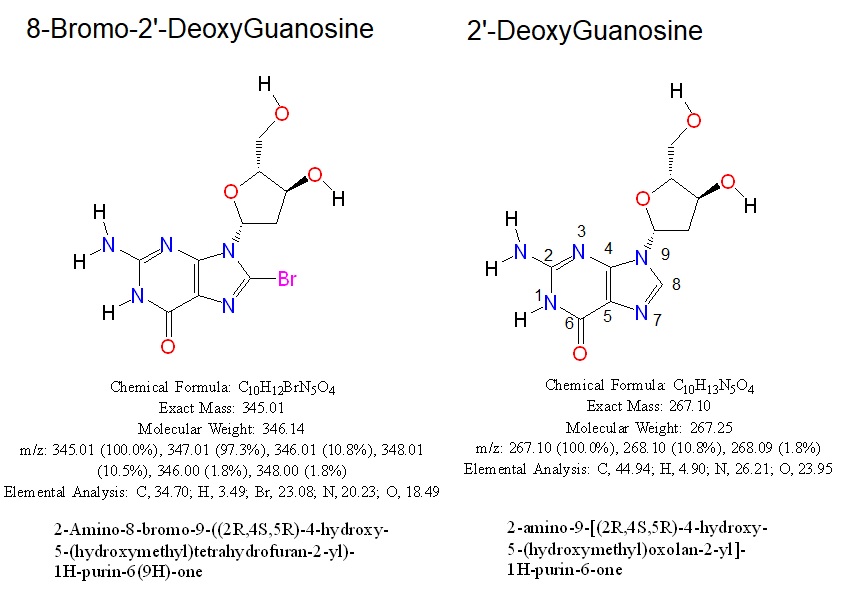8-Bromo-2'-deoxyguanosine, 8-Br-dG, C10H12BrN5O4 , CAS 13389-03-2, 2-Amino-8-bromo-9-((2R,4S,5R)-4-hydroxy-5-(hydroxymethyl)tetrahydrofuran-2-yl)-1H-purin-6(9H)-one, 8-bromo-2'-dG, 8-Br-2'-dG. Mw: 346.14 g/mol.
The organobromine compound 8-bromo-2’-deoxyguanosine is a modified 2'-deoxyguanosine having a bromo substituent at position 8 of the guanine ring system and a member of guanosines. A dG to 8Br-dG substitution is useful approach for the study of DNA and RNA structures, for example, the study of DNA and RNA G-quadruplexes.

Purine nucleosides with bulky substituents at the 8-position favor the syn conformation at the N-glycoside bond. The substitution of Guanosine by 8-bromoguanine on an alternating CG decamer stabilizes the Z-form in such a way that the B-form is not observed. Also, measurements of melting temperatures indicated that duplexes in which 8-bromo-2'-deoxyguanosine paired with natural bases are less stable. The incorporation of 8-bromo-2'-deoxyguanosine into oligonucleotides allows probing syn-anti conformational preferences in G-quartet structures. The bromination of poly (d(GC)) stabilizes the Z-DNA form. For example, a modification of 38% 8-bromoguanine and 18% 5-bromocytosine is enough to favor a stable Z-DNA helix in physiological conditions.
An extended expansion of the GGGGCC repeat within the non-coding region of the C9orf72 gene has been identified as the most common cause of familial amyotrophic lateral sclerosis (ALS) and frontotemporal dementia (FTD). Both are devastating neurodegenerative disorders. Therefore, the formation of an unusual secondary structures within expanded GGGGCC repeat, including DNA and RNA G-quadruplexes and R-loops was proposed as a driver of ALS and FTD pathogenesis. NMR structural investigation of DNA oligonucleotides with four repeat units with the ability to form an unimolecular G-quadruplex indicated their folding into multiple G-quadruplex structures in the presence of K(+) ions.
A single dG to 8Br-dG substitution at position 21 in oligonucleotide d[(G4C2)3G4] and optimization of folding conditions enabled the formation of mostly a single G-quadruplex species. The G-quadruplex structure of d[(G4C2)3GG(Br)GG] is composed of four G-quartets, connected by three edgewise C-C loops. All four strands adopt antiparallel orientation to one another and have alternating syn-anti progression of glycosidic conformation of guanine residues. One of the cytosines in every loop is stacked upon the G-quartet, contributing to a very compact and stable structure (Brčić and Plavec 2015).
Molecular models of 8-Br-dG, dG, and the GGGGCC repeat derived from the solution structure of a DNA quadruplex containing ALS and FTD related GGGGCC repeat stabilized by 8-bromodeoxyguanosine substitution [PDB 2N2D].
Reference
Brčić J, Plavec J. Solution structure of a DNA quadruplex containing ALS and FTD related GGGGCC repeat stabilized by 8-bromodeoxyguanosine substitution. Nucleic Acids Res. 2015 Sep 30;43(17):8590-600. doi: 10.1093/nar/gkv815. Epub 2015 Aug 7. PMID: 26253741; [PMCID: PMC4787828].
Fábrega, C., Macías, M.J., Eritja, R.; Synthesis and properties of oligonucleotides containing 8-bromo-2’-deoxyguanosine. Nucleosides Nucleotides & Nucleic Acids, 20(3), 251- 260 (2001). PMID: 11393401, doi: 10.1081/NCN-100002085. [ACS]
DeJesus-Hernandez M, Mackenzie IR, Boeve BF, Boxer AL, Baker M, Rutherford NJ, Nicholson AM, Finch NA, Flynn H, Adamson J, Kouri N, Wojtas A, Sengdy P, Hsiung GY, Karydas A, Seeley WW, Josephs KA, Coppola G, Geschwind DH, Wszolek ZK, Feldman H, Knopman DS, Petersen RC, Miller BL, Dickson DW, Boylan KB, Graff-Radford NR, Rademakers R. Expanded GGGGCC hexanucleotide repeat in noncoding region of C9ORF72 causes chromosome 9p-linked FTD and ALS. Neuron. 2011 Oct 20;72(2):245-56. doi: 10.1016/j.neuron.2011.09.011. Epub 2011 Sep 21. PMID: 21944778; [PMCID: PMC3202986].
Syn conformation
---...---